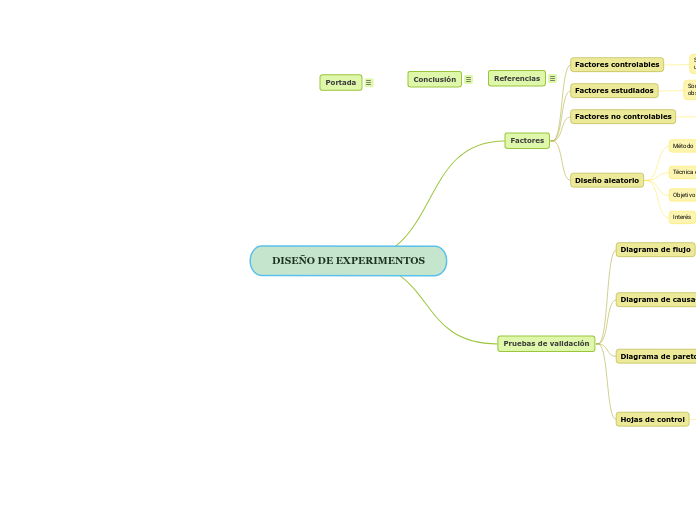por arturo mendez hace 5 años
1012
DISEÑO DE EXPERIMENTOS

por arturo mendez hace 5 años
1012

Ver más
MATERIA:
ALUMNO: JORGE ARTURO MÉNDEZ PÁJARO
PROFESOR: CARLOS CARRIZOSA DAVILA
ACTIVIDAD:
Actividad CUADRO SINÓPTICO
CAMPUS: PUEBLA
FECHA: 16/11/2020
Para concluir determinamos que el diseño de experimentos es una herramienta que se puede utilizar para encontrar la mejor relación entre los factores que intervienen en un proceso y la mayor rentabilidad en los procesos
Universidad de Granada. (s.f.).
Capítulo 3: Diseño estadístico de experimentos. Contenidos de Fundamentos de Biología Aplicada I
UCI (s.f.).
3.1 ¿Qué es una herramienta para control y la mejora de la calidad?
Gutiérrez, H.; de la Vara, R. (2003). Análisis y diseño de experimentos. McGraw-Hill, México.
Vicente, M.L.; Girón, P.; Nieto, C.; Pérez, T. (2005). Diseño de experimentos. Soluciones con SAS y SPSS. Pearson Educación, Madrid.
Tenses demonstrate the time of actions centered around the subject of the sentence. These actions are called verbs and change according to tenses.
There are four Past tenses:
Past Perfect Continuous is used:
Some adverbs used with Past Perfect Continuous:
Structure:
Subject + had been + Verb-ING
e.g. They had been talking for over an hour before I arrived.
Proporciona datos fáciles de comprender. Reflejan rápidamente las tendencias y patrones derivados de los datos. Proporciona registros históricos. Facilita el inicio del pensamiento estadístico. Ayuda a traducir las opiniones en hechos y datos
Type in your own examples or you can also choose from the examples below.
Form of verb 'to be':
Form of verb 'to have':
Past Perfect Simple is used for:
The Past Perfect tense is not normally used alone. It is used to denote the earlier of two past actions. We use Past Simple for the latter action.
Some adverbs used with Past Perfect Simple:
Structure:
Had + Subject + Past Participle?
e.g. Had they met Sarah before the party?
Ayuda a concentrarse en las causas que tendrán mayor impacto en caso de ser resueltas. Proporciona una visión simple y rápida de la importancia relativa de los problemas. Ayuda a evitar que se empeoren algunas causas al tratar de solucionar otras y ser resueltas
Type in your own examples or you can also choose from the examples below.
Form of word "to be":
Form of word "to have":
Past Continuous is used for:
Some adverbs used with Past Continuous:
Structure:
Was/ were + Verb-ING?
e.g. Were you studying when she called?
Mejoras de los procesos; Identificación de causas; Jerarquización de las causas encontradas; Mayor visibilidad de los problemas; Registro visual, facilitando análisis futuros; Participación del equipo en la gerencia de calidad; Organización de ideas; Trabajo en equipo.
Type in your own examples or you can also choose from the examples below.
Form of word "to be":
Form of word "to have":
Past simple expresses:
Some adverbs used with Past Simple:
Structure:
Did + subject + Base Form of the Verb?
e.g. Where did you meet her?
Ayudan a ilustrar modelos y a conectar ideas. Favorecen la comprensión del proceso. Permiten identificar los problemas y las oportunidades de mejora del proceso
Type in your own examples or you can also choose from the examples below.
Form of word "to be":
Form of word "to have":
There are four Present tenses:
Present Continuous is used to indicate the ongoing time (now).
Some adverbs used with Present Continuous:
Un solo factor con varios niveles
Structure:
BE + Subject + Verb-ING?
Are you eating now?
Comparare varios grupos o tratamientos
Type in your own examples or you can also choose from the examples below.
Form of word "to be":
Form of word "to have":
Structure:
Subject + BE not + Verb-ING
e.g. You are not eating now.
Análisis de varianza de un factor
Type in your own examples or you can also choose from the examples below.
Form of word "to be":
Form of word "to have":
Structure:
Subject + BE (am/is/are) + Verb-ING
e.g. You are eating now.
Descomposición de varianza total de un experimento en componentes independientes
Type in your own examples or you can also choose from the examples below.
Form of verb 'to be':
Form of verb 'to have':
Present Perfect Continuous is used:
Some adverbs used with Present Perfect Continuous:
Structure:
Have/ has + Subject + been Verb-ING?
e.g. How long has he been learning German?
Present Perfect is used for:
Some adverbs used with Present Perfect: